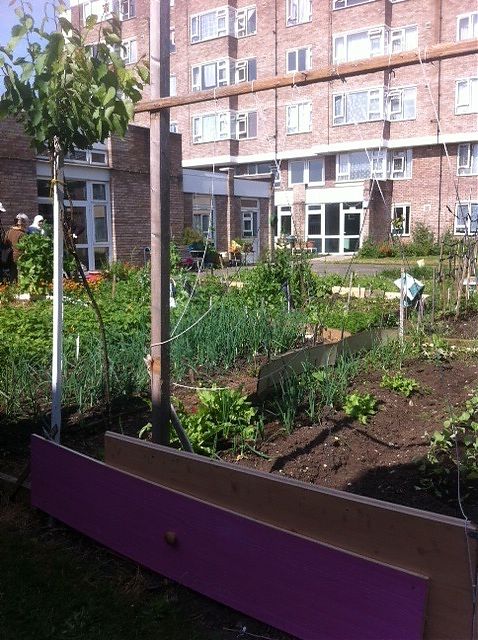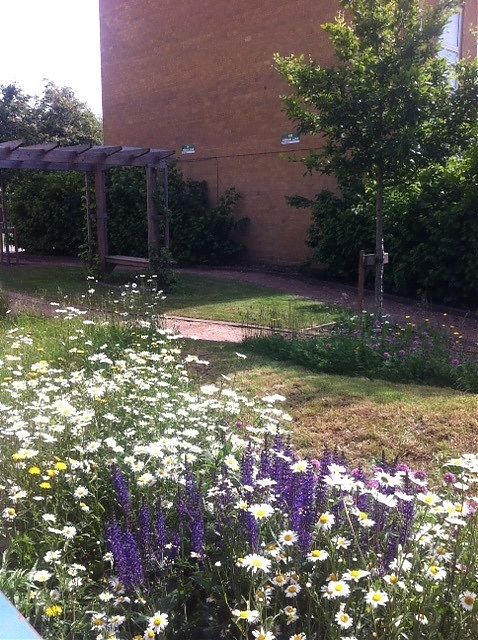Five lessons for London from Clapton's verdant "poppy" estate
Mike Pollitt | Wednesday 13 June, 2012 12:48

The estates of Clapton Park are in bloom. For over a decade their communal spaces have been maintained in a different way to most other estates, with a focus on flowers, food and reducing herbicides. The fruits of this stewardship are all around. I took a look last week as part of a tour given for the Chelsea Fringe. Here are some things I learnt.
1. People come first
John Little, whose Grass Roof Company maintains the estate on behalf of the tenants association, is clear where his priorities lie. Birds and bees are all very well, but it’s people he really wants to please. The estates form a island of biodiversity in the tarmacked city, but not an any cost. “We talk about biodiversity if we’re applying for grants”, says John. But wildflower stems are not left on the ground for overwintering insects. The residents don’t want that, they think it looks messy. The residents get what they want. This is important, he says, because otherwise the whole project could break down. There’s a lesson here for environmentalists: compromise might not be perfect, but it’s better than nothing at all.

2. There’s no accounting for taste. Estate residents massively underrate the delicious taste of rosemary
The founding legend of the poppy estate says that one resident, Fatima, began it all by sowing coriander seeds under a rose bush outside her flat. From these handsown seeds did all the others grow. Now the estates have four veg plots, and walls are lined with communal herbs – free for anyone to come and pick. The local preferences surprised me. Mint is very popular, by all accounts. Rosemary grows strong and healthy, but only because it is never plucked. Exotic vines coil round pillars, railings and posts. They are grown not for the grapes, but for the leaves, which the estate’s Turkish residents use in their cooking. Sounds delicious. But come on guys, eat some rosemary!
3. Gradual change is good
The first wildflowers were sown around 2000. Progress since then has been gradual, dependent on funding and the wishes of the residents. In 2007 the estate went to the Chelsea Flower Show proper. John emphasisied that many years of piecemeal impovement have created the estate as it is now. It simply wouldn’t have been possible to impose this change from above.

4. There’s a bit of grant money and support around if you know where to look
Rob Elliott, one of the residents accompanying the tour, told me that Capital Growth is a source of financial support for food-growing projects. Anyone with any interest in urban food growing should check out their website. Rob also drew this brilliant map which you can use to guide yourself round the estate.
5. It takes people to make things happen
This all started from residents like Fatima planting their own seeds. Then the tenants association appointed a forward thinking maintenance firm, led by John Little, to look after the estate. Spaces were created for vegetables to be grown, and people started to grow them. People like Rob filled in forms, applied for grants and improved their own parts of the estate. Other residents, who liked the old grass spaces, perhaps for their children to play in, allowed some spaces to be given up for different uses, like vegetables. The result is really lovely, but it didn’t happen by chance. It was people who made it happen.
The Clapton Park, Millfields and Nye Bevan Estates can be found here. The 242 bus is probably your best bet.
Snipe Highlights
Some popular articles from past years
- Margaret Thatcher statue rejected by public
- Nice map of London's fruit trees shows you where to pick free food
- Peter Bayley has worked for 50 years as a cinema projectionist in East Finchley
- London has chosen its mayor, but why can’t it choose its own media?
- The five spookiest abandoned London hospitals
- Nice Interactive timeline lets you follow Londoners' historic fight against racism
- Silencing the Brick Lane curry touts could be fatal for the city's self-esteem
- Only 16 commuters touch in to Emirates Air Line, figures reveal
- The best church names in London, and where they come from
- Could red kites be London's next big nature success story?
© 2009-2025 Snipe London.
